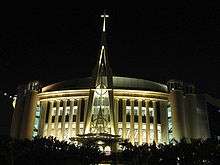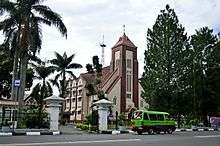Protestantism in Indonesia

Protestantism (Indonesian: Protestanisme) is one of the six approved religions in the country, the others being Islam, Roman Catholicism, Hinduism, Buddhism, and Confucianism. It constitutes the bulk of Christianity in Indonesia, which is the second largest religion in the country after Islam. According to CIA statistic, in 2000 5.7% of the population of Indonesia were Protestant.[1] A nationwide census of 2010 noted almost 7% (16,530,000)[2] of the population considering themselves Protestant, largest in Southeast Asia.
Protestantism is largely a result of Dutch Reformed and Lutheran missionary efforts during the country's colonial period.[3][4][5] The Dutch East India Company regulated the missionary work so it could serve its own interests and restricted it to the eastern part of the Indonesian archipelago.[6] Although these two branches are the most common, a multitude of other denominations can be found elsewhere in Indonesia.[7] The Batak Protestant Christian Church, founded in 1861 by German Lutheran missionary Ludwig Ingwer Nommensen, is the largest one.[8]
History
Protestantism arrived in Indonesia during the Dutch East Indies colonization. By the mid-1700s a significant Lutheran presence was found in Jakarta, with a Lutheran church built by the Lutheran Governor General Gustaaf Willem van Imhoff in 1749.[9] In 1817, the Dutch founded the Protestantsche Kerk in Nederlandsch-Indie ("Indische Kerk") as a union of Reformed, Lutheran, Baptists, Arminian and Mennonite denominations.[10] In 1835, the Dutch king decreed that one church council would fuse and oversee the Protestant denominations in the Dutch colony.[11]
Demographics
On the island of Sulawesi, 17% of the citizens are Protestants, particularly in Tana Toraja and North Sulawesi. Up to 65% of the Torajan population are Protestant. In some parts of the country, entire villages belong to a distinct denomination, such as Adventist, Lutheran, Presbyterian or Salvation Army. Two provinces have Protestant majorities: North Sulawesi (64%) and Papua (60%). Gereja Injili di Tanah Jawa is a Mennonite-related denomination. Huria Kristen Batak Protestant is a Lutheran denomination founded by Ludwig Ingwer Nommensen. It is the largest Protestant denomination in Indonesia and has over 4 million congregants.[12] The relatively large number of "denominations" per capita in Indonesia may be due to the significant number of different ethnic groups in Indonesia. Many Indonesian Protestants tend to congregate based more on ethnicity than liturgical differences.[13]
Reformed denominations

The Reformed faith bought by Dutch missionaries in the 17th century. Many of these churches are members of the World Communion of Reformed Churches:[14]
- Christian Evangelical Church in Sangihe-Talaud (GMIST)
- Christian Evangelical Church in Minahasa
- Christian Church in East Timor
- Christian Church in Luwuk Banggai
- Christian Church in Central Sulawesi
- Christian Church of Southern Sumatra
- Christian Church of Sumba
- Church of Toraja Mamasa
- East Java Christian Church
- Evangelical Christian Church in Halmahera
- Evangelical Christian Church in Papua
- Evangelical Church in Bolaang Mongondow
- Evangelical Church in Kalimantan
- Indonesian Christian Church
- Indonesian Protestant Church in Buol Toli-Toli
- Indonesian Protestant Church in Donggala
- Indonesian Protestant Church in Gorontalo
- Javanese Christian Church (Sinode Gereja-gereja Kristen Jawa, GKJ)
- Karo Batak Protestant Church
- Pasundan Christian Church
- Protestant Christian Church in Bali
- Protestant Church in Indonesia
- Protestant Church of Maluku
- Protestant Church in Southeast Sulawesi
- Protestant Church in West Indonesia
- Protestant Evangelical Church in Timor
- Toraja Church
Members of the International Conference of Reformed Churches
Members of World Reformed Fellowship
Lutheran denominations
Indonesian churches recognized by the Lutheran World Federation as Lutheran or affiliated with Lutheran are:
- Banua Niha Keriso Protestan (BNKP) – The Protestant Church in Nias Island
- Gereja Angowuloa Masehi Indonesia Nias (AMIN) – Christian Communion of Indonesia in Nias
- Gereja Kalimantan Evangelis (GKE) - Evangelical Church in Kalimantan. Also a member of the World Communion of Reformed Churches.
- Gereja Kristen Luther Indonesia (GKLI) – Indonesian Christian Lutheran Church
- Gereja Kristen Protestan Angkola (GKPA) – Christian Protestant Angkola Church
- Gereja Kristen Protestan di Mentawai (GKPM) – Protestant Christian Church in Mentawai (fka PKPM)
- Gereja Kristen Protestan Indonesia (GKPI) – Christian Protestant Church in Indonesia
- Gereja Kristen Protestan Pakpak Dairi (GKPPD) – Pakpak Dairi Protestant Christian Church
- Gereja Kristen Protestan Simalungun (GKPS) – Simalungun Protestant Christian Church
- Gereja Masehi Injili Minahasa (GMIM) - Christian Evangelical Church in Minahasa. Also a member of the World Communion of Reformed Churches.
- Gereja Punguan Kristen Batak (GPKB) – Batak Christian Community Church
- Gereja Protestan Persekutuan (GPP) – The United Protestant Church
- Huria Kristen Batak Protestan (HKBP) – Protestant Christian Batak Church
- Huria Kristen Indonesia (HKI) – The Indonesian Christian Church (a.k.a. Christian Church in Mentawai)
- Orahua Niha Keriso Protestan (ONKP) - Communion of Protestant Christian Church
HKI, GMB, GKPS, GKPI, GKLI, GKPA, GPP, and GKPPD all split from HKBP.[18] GKLI maintains a strong relationship with the Norwegian Lutheran Church. GKPM was founded by HKBP missionaries.[19] Although the BNKP and HKBP have historically cooperated, no official relationship exists between those entities. AMIN split from BNKP and retains more of a Lutheran identity.[20]
Gereja Lutheran Indonesia (GLI) is affiliated with the Confessional Evangelical Lutheran Conference. GLI is closely associated with the Wisconsin Evangelical Lutheran Synod in the United States. GLI has offices in Jakarta and operates a seminary, Sekolah Tinggi Teologi Lutheran (STTL), in Yogyakarta. GLI has large congregations on Java and in West Timor, as well as posts in Papua and Kalimantan.[21][22]
See also
References
- ↑ CIA Factbook
- ↑ "Penduduk Menurut Wilayah dan Agama yang Dianut" [Population by Region and Religion]. Sensus Penduduk 2010. Jakarta, Indonesia: Badan Pusat Statistik. 15 May 2010. Retrieved 20 Nov 2011.
Religion is belief in Almighty God that must be possessed by every human being. Religion can be divided into Muslim, Christian, Catholic, Hindu, Buddhist, Hu Khong Chu, and Other Religion.
Muslim 207176162 (87.18%), Christian 16528513 (6.96), Catholic 6907873 (2.91), Hindu 4012116 (2.69), Buddhist 1703254 (0.72), Khong Hu Chu 117091 (0.05), Other 299617 (0.13), Not Stated 139582 (0.06), Not Asked 757118 (0.32), Total 237641326 - ↑ Ricklefs 1991, pp. 28, 62.
- ↑ Vickers 2005, p. 22.
- ↑ Goh, Robbie B.H. (2005). Christianity in Southeast Asia. Institute of Southeast Asian Studies. p. 80. ISBN 981-230-297-2.
- ↑ Encyclopedia of Protestantism: 4-volume Set by Hans J. Hillerbrand, chapter on Indonesia, p. 824
- ↑ "Indonesia - (Asia)". Reformed Online. Reformed Online. Retrieved 7 October 2006.
- ↑ Encyclopedia of Protestantism: 4-volume Set by Hans J. Hillerbrand, chapter on Indonesia, p. 337
- ↑ Aritonang, Jan Sihar; Steenbrink, Karel, eds. (2008), A history of Christianity in Indonesia, Leiden, The Netherlands: Koninklijke Brill NV, pp. 122–123, ISBN 978-90-04-17026-1, retrieved 30 November 2010
- ↑ Aritonang, Jan Sihar; Steenbrink, Karel, eds. (2008), A history of Christianity in Indonesia, Leiden, The Netherlands: Koninklijke Brill NV, p. 384, ISBN 978-90-04-17026-1, retrieved 30 November 2010
- ↑ Aritonang, Jan Sihar; Steenbrink, Karel, eds. (2008), A history of Christianity in Indonesia, Leiden, The Netherlands: Koninklijke Brill NV, p. 647, ISBN 978-90-04-17026-1, retrieved 30 November 2010,
Protestants--European or Indonesian--living in the major cities mostly belonged to the Protestant Church in the Dutch East Indies, the Indische Kerk. The status of this church was in some respects quite different from that of the Catholic community, because it was placed more directly under government authority. By a decree of 11 December 1835 the Dutch king, Willem I, commanded the fusion of the Lutheran and Reformed denominations (only effected in 1854), and the establishment of one church council for the whole colony (realised in 1844).
- ↑ Muanda, Colette (January 2011). "2010 World Lutheran Membership Details" (PDF). LWF Statistics 2010. Geneva, Switzerland: [Lutheran World Federation]. p. 7. Archived from the original (PDF) on 26 September 2011. Retrieved 15 July 2011.
- ↑ Aritonang, Jan Sihar; Steenbrink, Karel, eds. (2008), A history of Christianity in Indonesia, Leiden, The Netherlands: Koninklijke Brill NV, p. 617, ISBN 978-90-04-17026-1, retrieved 30 November 2010,
It is remarkable that in the merger of the BKP with the BNKP the choice for unification was made on cultural rather than denominational grounds. While the Batunese congregations show distinctly Lutheran traits, especially in liturgical matters, the sense of communion is determined by ethno-cultural relations. Similar language and customary law, and especially family links between Nias and the Batu Islands, by far outweigh eccliastical tradition.
- ↑ "Archived copy". Archived from the original on 2012-08-08. Retrieved 2013-08-18.
- ↑ International Conference of Reformed Churches
- ↑ http://icrconline.com/members.html
- ↑ "Archived copy". Archived from the original on 2012-07-30. Retrieved 2013-02-17.
- ↑ Aritonang, Jan Sihar; Steenbrink, Karel, eds. (2008), A history of Christianity in Indonesia, Leiden, The Netherlands: Koninklijke Brill NV, p. 558, ISBN 978-90-04-17026-1, retrieved 30 November 2010
- ↑ Aritonang, Jan Sihar; Steenbrink, Karel, eds. (2008), A history of Christianity in Indonesia, Leiden, The Netherlands: Koninklijke Brill NV, p. 619, ISBN 978-90-04-17026-1, retrieved 30 November 2010
- ↑ Aritonang, Jan Sihar; Steenbrink, Karel, eds. (2008), A history of Christianity in Indonesia, Leiden, The Netherlands: Koninklijke Brill NV, p. 611, ISBN 978-90-04-17026-1, retrieved 30 November 2010
- ↑ "Gereja Lutheran Indonesia". Confessional Evangelical Lutheran Conference. Retrieved 24 Oct 2014.
- ↑ "INDONESIA". Wisconsin Evangelical Lutheran Syno. Retrieved 24 Oct 2014.
Further reading
- Kipp, Rita Smith (November 1995). "conversion by affiliation: the history of the Karo Batak Protestant Church". American Ethnologist. Arlington, VA: American Anthropological Association. 22 (4): 868–882. doi:10.1525/ae.1995.22.4.02a00110. JSTOR 646390.
- Pedersen, Paul (1970). Batak Blood and Protestant Soul: The Development of National Batak Churches in North Sumatra. Grand Rapids: William B. Eerdmans Publishing Co. doi:10.2307/3163048. OL 5753747M.

